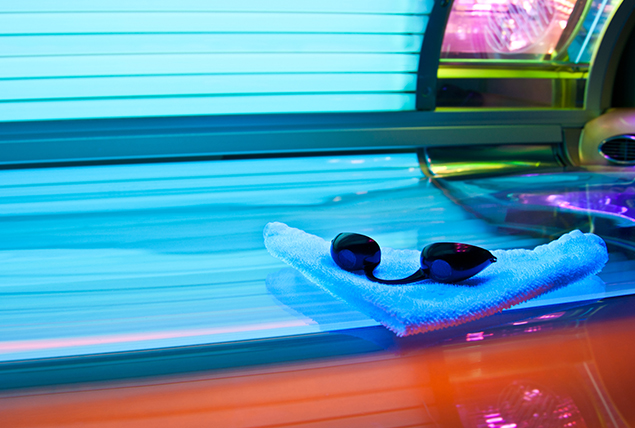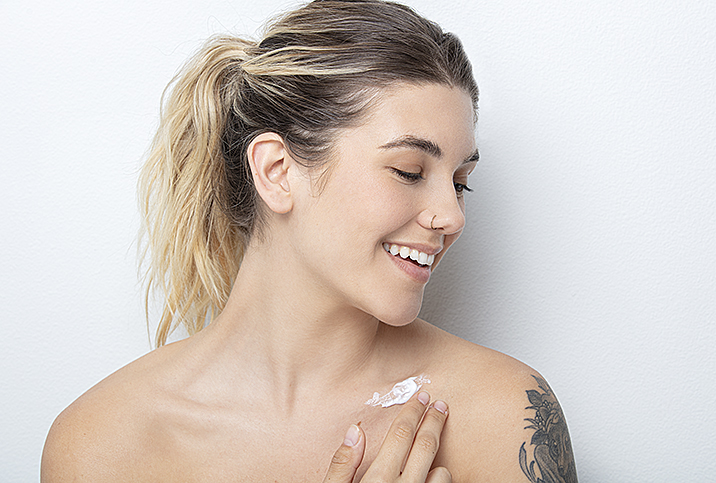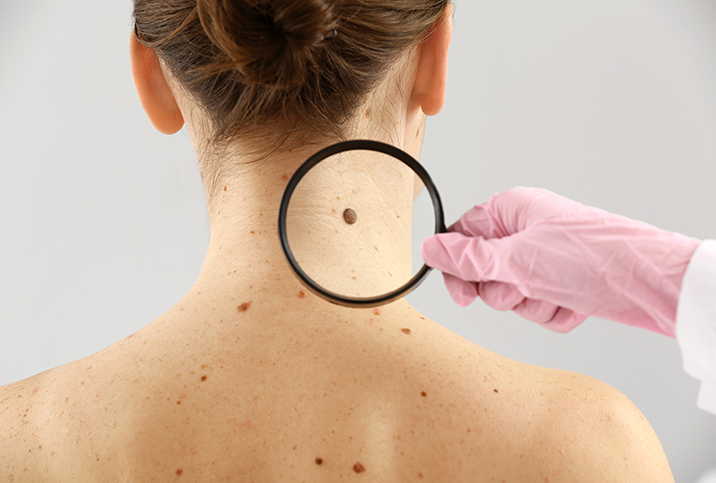Are Tanning Beds Bad for You? Here's What the Science Says

Key Points
- So you've used a tanning bed before. Does that put you at a greater risk of developing skin cancer?
- Even using a tanning bed once, regardless of your age or how long ago it was, increases your risk of skin cancer.
- Dermatologists discuss the risks of exposing yourself to UV light.
Millennials and Generation X have a higher chance of seeing red flags for skin cancer because of not following sun-safe habits, such as using tanning beds or substituting baby oil for sunscreen.
When it comes to those sunbeds specifically, though, how much is too much?
Even if you're now an SPF-every-day person but once indulged in tanning beds, how at risk are you for skin cancer? What are the early signs you can't ignore?
How bad is it to visit a tanning salon?
On the 2023 season of "The Kardashians," Khloe Kardashian opened up about discovering what she thought was a zit on her face but was actually skin cancer. She's not alone.
Gen Xers and millennials aren't following sun safety tips, a 2023 survey suggested.
"Going into a tanning bed just one time significantly increases your risk of developing skin cancer. Making a habit of it is practically guaranteeing that you will develop skin cancer in your early years. They are cancer-causing, period," said Vicki Rapaport, M.D., a board-certified dermatologist with a private practice in Beverly Hills, California.
Yes, even if you used a tanning bed just once, decades ago, you are more at risk for skin cancer than someone who has never used a tanning bed.
In 2009, the World Health Organization (WHO) International Agency for Research on Cancer (IARC) officially classified exposure to ultraviolet (UV) rays from tanning beds as a human carcinogen, meaning sunbeds cause cancer.
"Unfortunately, even if you used tanning beds at an early age but have completely stopped, you can still develop skin cancer 20 to 50 years later," Rapaport said.
People who have used a tanning bed at least once at any stage of their lives, even if they don't get a tanning bed burn, have a 20 percent higher risk of developing melanoma compared to someone who has never used a sunbed, Rapaport said.
Roughly 7.8 million women and 1.9 million men in the United States tan indoors each year, according to a 2015 report. That could put a large number of people at an increased risk.
Using a tanning bed before age 35 increases your risk of developing melanoma by 75 percent, according to the Skin Cancer Foundation.
How do tanning beds work?
Tanning beds are chambers lined with UV bulbs that emit high-intensity UV radiation. Since UV exposure releases melanin, the skin becomes darkened or tanned after a session, said Merry Thornton, P.A.-C., a licensed physician assistant and the founder of Element Medical Aesthetics in New Canaan, Connecticut.
Red-light therapy tanning beds don't use UV light and are not cancer-causing, but there's still a risk of damage to the skin and eyes if you use these beds too often or don't follow directions, according to Cleveland Clinic.
Recommended
- A Beginner's Guide to Skin Tags, Moles and Skin Cancer: Differentiating between typical and atypical dermatology can save your life.
- Sunscreen—Your Most Important Weapon Against Skin Cancer: Almost 10,000 Americans are diagnosed with a form of skin cancer each day—don't be one of them.
- 8 Ways to Prevent Skin Cancer: Summertime brings more sun exposure, but smart strategizing can save your skin.
Are there any tanning bed benefits?
UV radiation from tanning can help with inflammatory conditions such as eczema, vitiligo and psoriasis, Thornton said, but the risks outweigh the potential benefits for most people.
Those risks include tanning bed rash, itchiness, skin cancer and increasing skin age. And they can happen with even moderate use and "far exceed" any potential benefits, said Vladyslava Doktor, D.O., a dermatologist and owner of Skin Center Boston.
Can you get vitamin D from a tanning bed?
Getting vitamin D from tanning beds is "one of the most common justifications that my patients give me when I ask why they are using tanning beds," said Noreen Galaria, M.D., a dermatologist and CEO and co-founder of Inner Glow in Northern Virginia.
You don't get enough vitamin D from tanning beds to make it worth the risk.
Tanning beds emit about 95 percent of UVA rays and 5 percent of UVB rays. The body needs UVB rays to make vitamin D. This is why dermatologists recommend getting vitamin D from your diet and not from tanning beds, according to Thornton.
Can you use a tanning bed while pregnant?
There are no studies that involve pregnant women and tanning beds, but pregnant women should avoid tanning beds for a couple of reasons. One, to avoid the risk of skin cancer, and two, to avoid the risk of overheating, Thornton said.
"While tanning booths are composed of light bulbs of high-intense radiation of ultraviolet light, they are not necessarily contraindicated during pregnancy. However, since pregnancy is considered an immunosuppressed state, as is high doses of UV radiation, it could be a deadly combination and is absolutely not recommended," Rapaport said.
Are tanning beds worse than the sun?
About 10 minutes in a tanning bed equals about two hours of lying in the sun.
"Tanning beds are more dangerous than outdoor exposure because of the concentrated and rapid way the UV damage is delivered," Galleria said. "The only times I have ever recommended a tanning bed is in a few medical conditions where a patient was unable to get certain treatments covered, and we were desperate to get them some results, and even then we proceed in a controlled manner."
Tanning beds are more harmful than sunlight because they emit concentrated levels of UVA radiation that penetrate deeper into the skin and cause damage, leading to an increased risk of melanoma, the deadliest form of skin cancer, Doktor said.
What do dermatologists say about using indoor tanning beds?
"Never. Ever. Use. Tanning booths," Rapaport said.
"Dermatologists strongly discourage the use of indoor tanning beds," Doktor said.
The intensity of the UV rays from a tanning bed is "similar to being exposed to the sun without SPF protection and protective clothing," said Natalie Jones, M.D., a surgical oncologist with a focus on melanoma at Ohio Health Riverside Methodist Hospital in Columbus and Dublin, Ohio.
Since the WHO classified exposure to UV-emitting tanning devices as cancer-causing in 2009, more than 40 national or provincial authorities around the world have implemented outright bans or restrictions on the use of sunbeds, said Daniel Glass, M.D., a consultant dermatologist at the Dermatology Clinic in London.
"I am not aware of any dermatologists who encourage sunbed use," Glass said.
What are the downsides of indoor tanning beds?
The downsides of tanning beds include an increased risk of skin cancer, yes, but also premature aging by decreasing collagen in the skin, which causes the skin to look wrinkly and leathery, Thornton said.
Sunbeds can lead to a weakened immune system and eye damage.
"It's important to protect your skin from excessive UV radiation by avoiding tanning beds and practicing safe sun habits," Doktor said.
Are tanning beds safe in moderation?
What about those people who stop tanning before we turn the color of a Dorito? Is it OK to use a tanning bed a couple of times a week or fewer?
"Tanning beds are 100 percent not safe in moderation," Rapaport said.
"I compare tanning beds to smoking when talking to my patients," Galaria said. "Just like we thought smoking might be OK in moderation in the 1980s but then realized any amount was not really good for you, it's the same with tanning beds. Even one time in a tanning bed can increase your risk of skin cancer."
A tan is a sign of skin damage, as it increases melanin in the skin. This is the skin's way of trying to protect it from further damage, Thornton said.
'The best way to prevent skin cancer is sun avoidance. Sunscreen alone is not enough. I highly recommend that all my patients wear hats [and] long sleeves and seek shade.'
Indoor tanning can increase the risk of developing the two most common types of skin cancer: squamous cell carcinoma by 58 percent and basal cell carcinoma by 24 percent. Using tanning beds before age 20 can increase your chances of developing melanoma by 47 percent with an increase in risk with each use, according to the American Academy of Dermatology (AAD).
Every time you use a sunbed, you have a 1.8 percent increased risk of developing melanoma. The association between tanning beds and the risk of skin cancer shows the risk is highest in people who use tanning beds in early life, a 2012 study suggested.
What is skin cancer?
Skin cancer is a mutation or abnormal growth of skin cells typically caused by excessive exposure to UV radiation.
The types of skin cancer include the following:
- Basal cell carcinoma (BCC)
- Squamous cell carcinoma (SCC)
- Melanoma
What are the early signs of skin cancer?
"Early signs of skin cancer can include changes in the size, shape, color or texture of existing moles or the appearance of new growths on the skin," Doktor said.
BCC and SCC, the most common types of skin cancer, typically appear on areas of the skin exposed to the sun as nonhealing sores, red patches or shiny bumps, Doktor said.
Melanoma is a less common form of skin cancer but more aggressive. It can occur anywhere on the body and often presents as an unusual mole or a changing mole with irregular borders, color variations or diameter, Doktor said.
However, when melanoma is detected early, the five-year relative survival rate is 99 percent, according to the Skin Cancer Foundation.
When doctors are looking at skin lesions or moles, there are several signs they look for, including the following, Jones said:
- Are the moles or lesions more jagged than round and symmetrical?
- Are the margins of the mole regular?
- Has the mole changed from brown to black or red?
- Is it greater than 6 to 8 millimeters in size?
- Has the mole or lesion changed or evolved over time?
If any of these are true, you should see your dermatologist or physician, Jones said.
Where do women get skin cancer the most?
Skin cancer rates for women are higher before age 50 but become higher in men after age 50, according to the AAD.
"It is a well-known fact that the largest proportion of sunbed users are women, particularly young women," Rapaport said. "These women who have used sunbeds can develop skin cancer, literally anywhere from the top of their head to the bottom of the foot. If [they] have not used sunbeds, the most common area where women will develop skin cancers are their face, chest, arms and legs."
What can you do to help prevent skin cancer now?
To prevent skin cancer now, wear a sunscreen of SPF 30 or greater and regularly reapply it every two hours as well as when you come out of the water, since most sunscreens are not water resistant.
Wear protective clothing such as hats that cover your face and ears and/or UV-protective clothing that reflects UV rays. If you notice something new on your skin or if a mole or lesion is changing on your skin, report it to your dermatologist or physician.
If you are over age 40, schedule a yearly full-body skin check with your dermatologist or physician, Jones said.
"The best way to prevent skin cancer is sun avoidance. Sunscreen alone is not enough. I highly recommend that all my patients wear hats [and] long sleeves and seek shade," Rapaport said. "I honestly am [tired] of people who come in tan or even sunburned and say 'But I was wearing sunscreen.' Please know that sunscreen alone is not enough."
The bottom line
Yes, even if you used a tanning bed just once, decades ago, you are more at risk for skin cancer than someone who has never used a tanning bed.
Not only do dermatologists agree that everyone should avoid tanning beds, but tanning booths are officially labeled as cancer-causing.
Wear sunscreen. Keep an eye on your moles and skin lesions. If something looks different, consult with your doctor immediately.


















